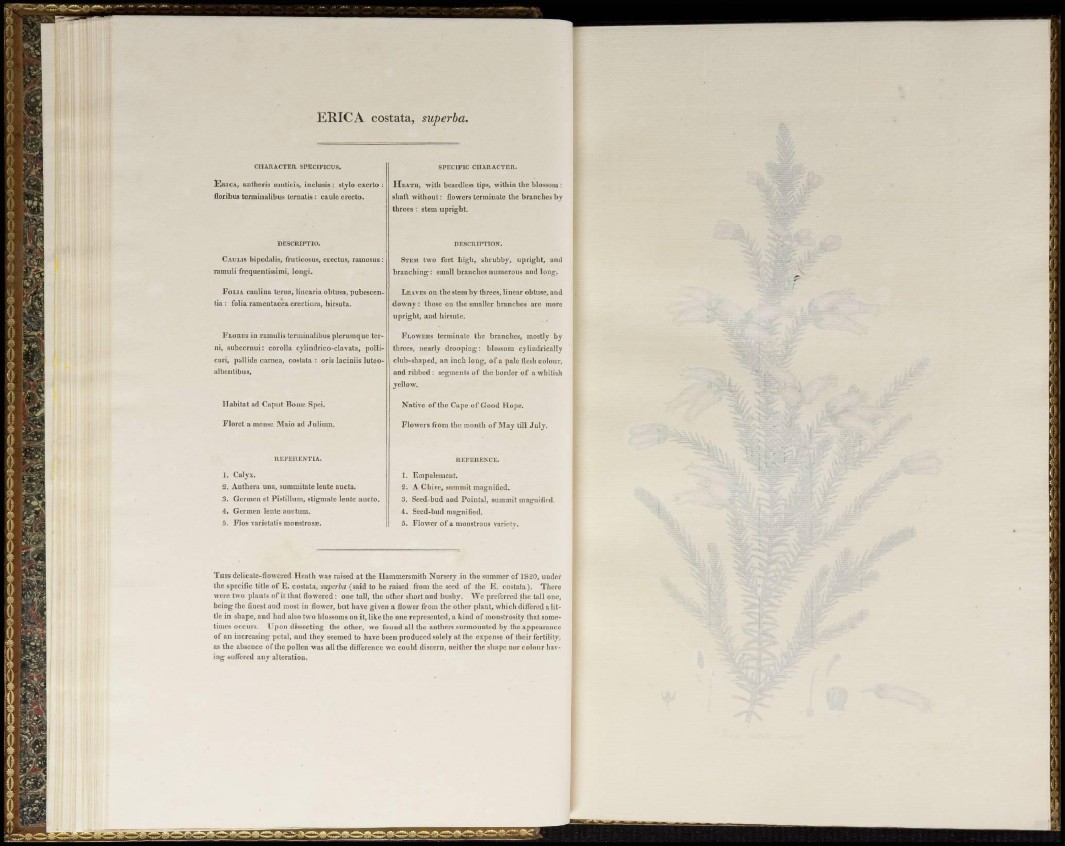
E R I C A costata, superba.
CHARACTER SPECIP1CUS.
ERICA, antheris muticis, inclusis : stylo exerto :
floribus terminalibus ternatis : caulc credo.
DESCRIFTIO.
CAULIS bipedalis, fruticosus, eiectus, rainosus:
ramuli frequentissimi, longi.
FOLIA caulina terna, linearía obtusa, pubescentia
: folia ramentacea erectiora, hirsuta.
FLORES in ramulis terminal i bus plerumque terni,
subecrnui: corolla cylindrico-clavata, pollicari,
pallide carnea, costata : oris laciniis luteoalbentibus.
Habitat ad Caput Bouoe Speí.
Floret a mense Maio ad Julium.
REFERENT I A.
1. Calyx.
2. Anthera una, summitaíe lente aucta.
3. Germen et Pistillum, stigmate lente aucto.
4. Germen lente auctum.
5. Flos varietatis monstross.
SPECIFIC CHARACTER.
HEATH, with beardless tips, within the blossom :
shaft without: flowers terminate the branches by
threes : stem upright.
DESCRIPTION.
STEM two feet high, shrubby, upright, and
branching: small branches numerous and long.
LEAVES on the stem by threes, linear obtuse, and
downy : those on the smaller branches are more
upright, and hirsute.
FLOWERS terminate the branches, mostly by
threes, nearly drooping: blossom cylindricallv
club-shaped, an inch long, of a pale ilesh colour,
and ribbed : segments of the border of a whitish
yellow.
Native of the Cape of Good Hope.
Flowers from the month of May till July.
REFERENCE.
1. Empalement.
2 . A Chive, summit magnified.
3. Seed-bud and Pointal, summit magnified.
4. Seed-bud magnified.
5. Flower of a monstrous variety,
THIS delicate-flowered Heath was raised at the Hammersmith Nursery in the summer of 1 8 2 0 , under
the specific title of E. costata, superba (said to be raised from the seed of the E. costata). There
were two plants of it that flowered : one tall, the other short and bushy. We preferred the tall one,
being the finest and most in flower, but have given a flower from the other plant, which differed a little
in shape, and had also two blossoms on it, like the one represented, a kind of monstrosity that sometimes
occurs. Upon dissecting the other, we found all the anthers surmounted by the appearance
of an increasing petal, and they seemed to have been produced solely at the expense of their fertility,
as the absence of the pollen was all the difference wc could discern, neither the shape nor colour having
suffered any alteration.